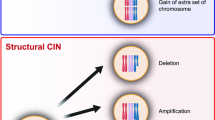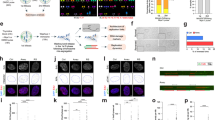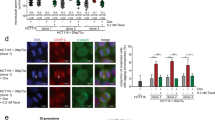Abstract
Centromeric instability is characterized by dynamic formation of centromeric breaks, deletions, isochromosomes and translocations, which are commonly observed in cancer. So far, however, the mechanisms of centromeric instability in cancer cells are still poorly understood. In this study, we tested the hypothesis that G2 checkpoint defect promotes centromeric instability. Our observations from multiple approaches consistently support this hypothesis. We found that overexpression of cyclin B1, one of the pivotal genes driving G2 to M phase transition, impaired G2 checkpoint and promoted the formation of centromeric aberrations in telomerase-immortalized cell lines. Conversely, centromeric instability in cancer cells was ameliorated through reinforcement of G2 checkpoint by cyclin B1 knockdown. Remarkably, treatment with KU55933 for only 2.5 h, which abrogated G2 checkpoint, was sufficient to produce centromeric aberrations. Moreover, centromeric aberrations constituted the major form of structural abnormalities in G2 checkpoint-defective ataxia telangiectasia cells. Statistical analysis showed that the frequencies of centromeric aberrations in G2 checkpoint-defective cells were always significantly overrepresented compared with random assumption. As there are multiple pathways leading to G2 checkpoint defect, our finding offers a broad explanation for the common occurrence of centromeric aberrations in cancer cells.
This is a preview of subscription content, access via your institution
Access options
Subscribe to this journal
Receive 50 print issues and online access
$259.00 per year
only $5.18 per issue
Buy this article
- Purchase on Springer Link
- Instant access to full article PDF
Prices may be subject to local taxes which are calculated during checkout




Similar content being viewed by others
References
Abraham RT . (2001). Cell cycle checkpoint signaling through the ATM and ATR kinases. Genes Dev 15: 2177–2196.
Bartkova J, Horejsi Z, Koed K, Kramer A, Tort F, Zieger K et al. (2005). DNA damage response as a candidate anti-cancer barrier in early human tumorigenesis. Nature 434: 864–870.
Beheshti B, Karaskova J, Park PC, Squire JA, Beatty BG . (2000). Identification of a high frequency of chromosomal rearrangements in the centromeric regions of prostate cancer cell lines by sequential giemsa banding and spectral karyotyping. Mol Diagn 5: 23–32.
Cheung PY, Deng W, Man C, Tse WW, Srivastava G, Law S et al. (2010). Genetic alterations in a telomerase-immortalized human esophageal epithelial cell line: implications for carcinogenesis. Cancer Lett 293: 41–51.
Deckbar D, Birraux J, Krempler A, Tchouandong L, Beucher A, Walker S et al. (2007). Chromosome breakage after G2 checkpoint release. J Cell Biol 176: 749–755.
Deng W, Tsao SW, Guan XY, Cheung AL . (2007). Microtubule breakage is not a major mechanism for resolving end-to-end chromosome fusions generated by telomere dysfunction during the early process of immortalization. Chromosoma 116: 557–568.
Deng W, Tsao SW, Kwok YK, Wong E, Huang XR, Liu S et al. (2008). Transforming growth factor beta1 promotes chromosomal instability in human papillomavirus 16 E6E7-infected cervical epithelial cells. Cancer Res 68: 7200–7209.
Deng W, Tsao SW, Lucas JN, Leung CS, Cheung AL . (2003). A new method for improving metaphase chromosome spreading. Cytometry A 51: 46–51.
Dillon N, Festenstein R . (2002). Unravelling heterochromatin: competition between positive and negative factors regulates accessibility. Trends Genet 18: 252–258.
Ehrlich M . (2002). DNA hypomethylation, cancer, the immunodeficiency, centromeric region instability, facial anomalies syndrome and chromosomal rearrangements. J Nutr 132: 2424S–2429S.
Eichler EE, Sankoff D . (2003). Structural dynamics of eukaryotic chromosome evolution. Science 301: 793–797.
Glaser R, Zhang HY, Yao KT, Zhu HC, Wang FX, Li GY et al. (1989). Two epithelial tumor cell lines (HNE-1 and HONE-1) latently infected with Epstein-Barr virus that were derived from nasopharyngeal carcinomas. Proc Natl Acad Sci USA 86: 9524–9528.
Gorgoulis VG, Vassiliou LV, Karakaidos P, Zacharatos P, Kotsinas A, Liloglou T et al. (2005). Activation of the DNA damage checkpoint and genomic instability in human precancerous lesions. Nature 434: 907–913.
Hanahan D, Weinberg RA . (2000). The hallmarks of cancer. Cell 100: 57–70.
Innocente SA, Abrahamson JL, Cogswell JP, Lee JM . (1999). p53 regulates a G2 checkpoint through cyclin B1. Proc Natl Acad Sci USA 96: 2147–2152.
Ito Y, Takeda T, Sakon M, Monden M, Tsujimoto M, Matsuura N . (2000). Expression and prognostic role of cyclin-dependent kinase 1 (cdc2) in hepatocellular carcinoma. Oncology 59: 68–74.
Jin Y, Mertens F, Jin C, Akervall J, Wennerberg J, Gorunova L et al. (1995). Nonrandom chromosome abnormalities in short-term cultured primary squamous cell carcinomas of the head and neck. Cancer Res 55: 3204–3210.
Johansson M, Jin Y, Mandahl N, Hambraeus G, Johansson L, Mitelman F et al. (1995). Cytogenetic analysis of short-term cultured squamous cell carcinomas of the lung. Cancer Genet Cytogenet 81: 46–55.
Kaufmann WK, Schwartz JL, Hurt JC, Byrd LL, Galloway DA, Levedakou E et al. (1997). Inactivation of G2 checkpoint function and chromosomal destabilization are linked in human fibroblasts expressing human papillomavirus type 16 E6. Cell Growth Differ 8: 1105–1114.
Kojis TL, Schreck RR, Gatti RA, Sparkes RS . (1989). Tissue specificity of chromosomal rearrangements in ataxia-telangiectasia. Hum Genet 83: 347–352.
Leach TJ, Chotkowski HL, Wotring MG, Dilwith RL, Glaser RL . (2000). Replication of heterochromatin and structure of polytene chromosomes. Mol Cell Biol 20: 6308–6316.
Li HM, Man C, Jin Y, Deng W, Yip YL, Feng HC et al. (2006). Molecular and cytogenetic changes involved in the immortalization of nasopharyngeal epithelial cells by telomerase. Int J Cancer 119: 1567–1576.
Lobrich M, Jeggo PA . (2007). The impact of a negligent G2/M checkpoint on genomic instability and cancer induction. Nat Rev Cancer 7: 861–869.
Nakamura N, Yamamoto H, Yao T, Oda Y, Nishiyama K, Imamura M et al. (2005). Prognostic significance of expressions of cell-cycle regulatory proteins in gastrointestinal stromal tumor and the relevance of the risk grade. Hum Pathol 36: 828–837.
Padilla-Nash HM, Heselmeyer-Haddad K, Wangsa D, Zhang H, Ghadimi BM, Macville M et al. (2001). Jumping translocations are common in solid tumor cell lines and result in recurrent fusions of whole chromosome arms. Genes Chromosomes Cancer 30: 349–363.
Pandita TK . (2002). ATM function and telomere stability. Oncogene 21: 611–618.
Perrod S, Gasser SM . (2003). Long-range silencing and position effects at telomeres and centromeres: parallels and differences. Cell Mol Life Sci 60: 2303–2318.
Pincheira J, Lopez-Saez JF . (1991). Effects of caffeine and cycloheximide during G2 prophase in control and X-ray-irradiated human lymphocytes. Mutat Res 251: 71–77.
Rainey MD, Charlton ME, Stanton RV, Kastan MB . (2008). Transient inhibition of ATM kinase is sufficient to enhance cellular sensitivity to ionizing radiation. Cancer Res 68: 7466–7474.
Santana C, Ortega E, Garcia-Carranca A . (2002). Oncogenic H-ras induces cyclin B1 expression in a p53-independent manner. Mutat Res 508: 49–58.
Stewenius Y, Gorunova L, Jonson T, Larsson N, Hoglund M, Mandahl N et al. (2005). Structural and numerical chromosome changes in colon cancer develop through telomere-mediated anaphase bridges, not through mitotic multipolarity. Proc Natl Acad Sci USA 102: 5541–5546.
Struski S, Doco-Fenzy M, Cornillet-Lefebvre P . (2002). Compilation of published comparative genomic hybridization studies. Cancer Genet Cytogenet 135: 63–90.
Suzuki T, Urano T, Miki Y, Moriya T, Akahira J, Ishida T et al. (2007). Nuclear cyclin B1 in human breast carcinoma as a potent prognostic factor. Cancer Sci 98: 644–651.
Takata M, Sabe H, Hata A, Inazu T, Homma Y, Nukada T et al. (1994). Tyrosine kinases Lyn and Syk regulate B cell receptor-coupled Ca2+ mobilization through distinct pathways. EMBO J 13: 1341–1349.
Takeno S, Noguchi T, Kikuchi R, Uchida Y, Yokoyama S, Muller W . (2002). Prognostic value of cyclin B1 in patients with esophageal squamous cell carcinoma. Cancer 94: 2874–2881.
Tang JC, Wan TS, Wong N, Pang E, Lam KY, Law SY et al. (2001). Establishment and characterization of a new xenograft-derived human esophageal squamous cell carcinoma cell line SLMT-1 of Chinese origin. Cancer Genet Cytogenet 124: 36–41.
Terzoudi GI, Manola KN, Pantelias GE, Iliakis G . (2005). Checkpoint abrogation in G2 compromises repair of chromosomal breaks in ataxia telangiectasia cells. Cancer Res 65: 11292–11296.
White JS, Choi S, Bakkenist CJ . (2008). Irreversible chromosome damage accumulates rapidly in the absence of ATM kinase activity. Cell Cycle 7: 1277–1284.
Wong N, Lai P, Pang E, Leung TW, Lau JW, Johnson PJ . (2000). A comprehensive karyotypic study on human hepatocellular carcinoma by spectral karyotyping. Hepatology 32: 1060–1068.
Xu B, Kim ST, Lim DS, Kastan MB . (2002). Two molecularly distinct G(2)/M checkpoints are induced by ionizing irradiation. Mol Cell Biol 22: 1049–1059.
Yin XY, Grove L, Datta NS, Katula K, Long MW, Prochownik EV . (2001). Inverse regulation of cyclin B1 by c-Myc and p53 and induction of tetraploidy by cyclin B1 overexpression. Cancer Res 61: 6487–6493.
Yoshida T, Tanaka S, Mogi A, Shitara Y, Kuwano H . (2004). The clinical significance of Cyclin B1 and Wee1 expression in non-small-cell lung cancer. Ann Oncol 15: 252–256.
Zhu D, Ma MS, Zhao RZ, Li MY . (1995). Centromere spreading and centromeric aberrations in ovarian tumors. Cancer Genet Cytogenet 80: 63–65.
Acknowledgements
We thank Dr Prochownik, Children's Hospital of Pittsburgh, Pittsburgh, PA, for the kind gift of pApuro-CyclinB1 plasmids, and Department of Pediatrics and Adolescent Medicine, The University of Hong Kong for use of SKY facilities. We also thank Dr JC Tang (Department of Applied Biology and Chemical Technology, The Hong Kong Polytechnic University) and Professor G Srivastava (Department of Pathology, The University of Hong Kong) for the SLMT-1 cell line, and Dr R Glaser (Department of Medical Microbiology and Immunology, Ohio State University Medical Center) for the HNE-1 cell line; T Chan, PY Cheung, CS Leung, P Mak, J Cheung, A Li and B Lai for technical assistance. This study was supported by a grant from the Research Grants Council of Hong Kong Special Administrative Region, China, Project No. HKU 7556/06M.
Author information
Authors and Affiliations
Corresponding author
Ethics declarations
Competing interests
The authors declare no conflict of interest.
Additional information
Supplementary Information accompanies the paper on the Oncogene website
Rights and permissions
About this article
Cite this article
Deng, W., Tsao, S., Mak, G. et al. Impact of G2 checkpoint defect on centromeric instability. Oncogene 30, 1281–1289 (2011). https://doi.org/10.1038/onc.2010.508
Received:
Revised:
Accepted:
Published:
Issue Date:
DOI: https://doi.org/10.1038/onc.2010.508
Keywords
This article is cited by
-
Hec1/Ndc80 is overexpressed in human gastric cancer and regulates cell growth
Journal of Gastroenterology (2014)



